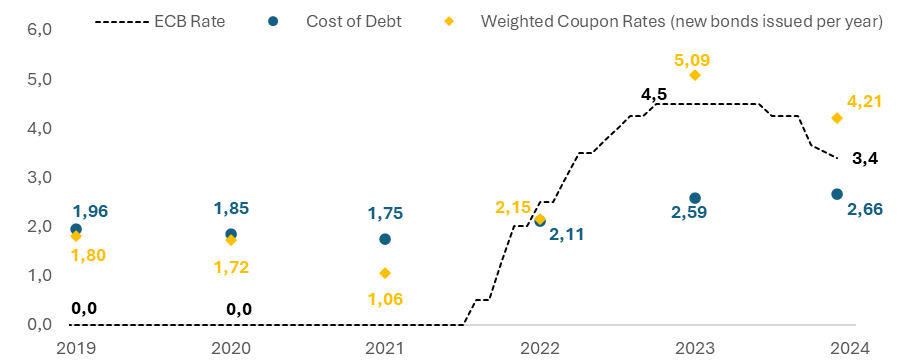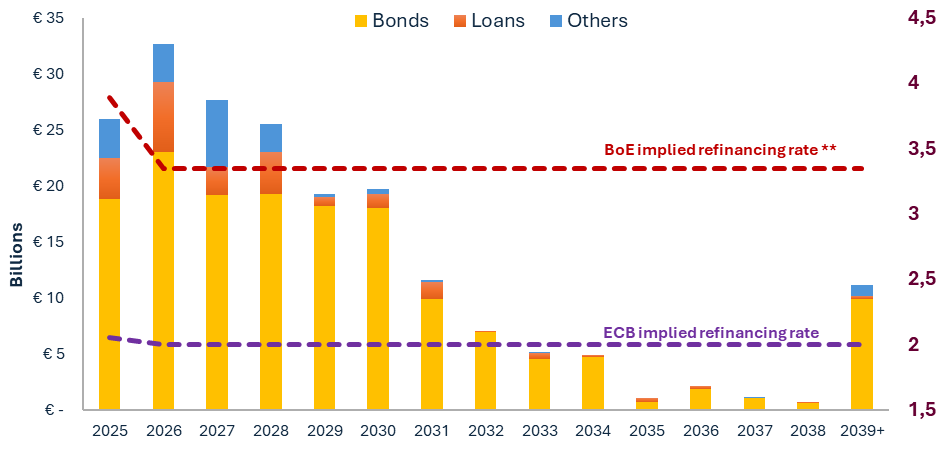Listed Real Estate and Cost of Debt: Prudent Optimism
by David Moreno CFA, Indexes Manager
In recent months, most central banks across Europe have shifted from a hawkish stance to a more accommodative monetary policy, marking the beginning of an interest rate-cutting cycle. In the Eurozone, after an intense period of rate hikes in 2022 and 2023, the ECB implemented four 25-basis-point cuts in 2024. In the UK, the movement was much more moderate, with just 2 movements by the Bank of England totaling a reduction of 50 bps, while the Swiss and Swedish national banks started the cutting cycle earlier and cut the interest rates by 125 bps and 150 bps respectively. This shift not only aims to avoid impacting economic growth under easing inflationary pressures but also brings renewed optimism to the listed real estate (LRE) sector, a key beneficiary of lower marginal borrowing costs. Under this new dynamic on interest rates, cost of debt becomes a key variable to analyze.
Although most central banks in Europe increased their rates by more than 400 bps in 2022 and 2023, the average overall debt costs for European property companies increased by only 91 bps, then making clear that the sector was well prepared for such changes, therefore, the easing cycle opens new opportunities and brings new dynamics to the sector (see our latest EPRA in-house report [1]).
Evolution of ECB Rate, Cost of Debt, and Coupon Rates for TOP50 Property Companies

Source: EPRA Research
The current pressure on Government bonds in Europe
Despite the cautious pace of rate cuts, government bonds across the continent recently experienced significant pressure, mostly as a result of an increasing fiscal and economic uncertainty. During the last 3 months, the yields of the 10y government bonds in Germany increased by 28 bps, in France by 27 bps, in Italy by 14 bps, in Switzerland by 15 bps, in Sweden by 28 bps, and 36 bps in the UK. However, European investors can remain optimistic. The ECB’s strategic shift is designed to stimulate lending activity, having real estate as one of the main industries benefiting from this movement and supporting returns and earnings from listed property companies.
Why Listed Real Estate is Poised to Benefit
As explained in our previous article, available here, the listed real estate sector has historically shown strong performance during most rate-cutting cycles. Data from previous cycles (2001–2016) demonstrates that LRE outperformed common equities in Europe, with an average annualized price return of 12.18% in the year following the first rate cut. This resilience is underpinned by structural factors unique to the European market, including prudent leverage practices and the sector’s sensitivity to short-term interest rate movements. However, past cycles show mixed performance outside Europe, indicating that local factors play a critical role in shaping outcomes.
Refinancing Costs: A Manageable Challenge
European property companies are navigating a period of increased refinancing activity, with approximately 43% of outstanding debt maturing between 2025 and 2027. Encouragingly, lower policy rates are expected to reduce refinancing costs compared to the elevated borrowing costs of the past two years. Although the average cost of debt has risen moderately, from 1.75% at the end of 2021 to 2.66% in June 2024, it remains manageable and reflects a sector that has adapted well to a higher-rate environment.
Average cost of debt by currency (%)

Source: EPRA Research
Moreover, European property companies’ proactive approach to managing their debt profiles has bolstered their resilience. Higher proportion of fixed rate debt, moderate D/E ratios and longer debt maturity are just some of the key achievements reached by the industry in the last decade (for more detailed insights read EPRA in-house report [2]). In addition, approximately 80% of outstanding debt consists of bonds, which typically offer longer maturities and more predictable cost structures compared to bank loans. This strategic shift reduces exposure to short-term rate volatility and underscores the sector’s ability to navigate evolving monetary conditions.
Debt maturity for constituents of the FTSE EPRA Nareit Developed Europe Index

** Implied rates from the Interest Rate Swaps market
Source: EPRA Research & Bloomberg
Looking ahead, the average cost of debt is projected to rise modestly as companies refinance existing obligations issued at historically low rates. However, this increase is expected to be gradual and manageable, particularly as central banks continue to ease monetary policy.
A Positive Outlook for Earnings and Valuations
Despite the challenges posed by rising financing costs and declining property valuations in recent years, the outlook for LRE is increasingly optimistic. Rental yields are expected to rise modestly, maintaining a favourable spread over financing costs. This spread is critical for sustaining positive leverage and driving earnings growth.
Operational metrics in the sector remain strong, supported by reasonable loan-to-value (LTV) ratios and disciplined capital management. European property companies have made significant efforts to strengthen their debt profiles, positioning themselves to capitalize on the benefits of lower interest rates. As a result, we anticipate a shift in earnings from capital losses to income generation, leading to improved profitability metrics such as return on equity (ROE) and return on assets (ROA).
Conclusion: A Promising Recovery for LRE
The listed real estate sector in Europe is well-positioned to benefit from the ongoing interest rate-cutting cycle. With central banks likely to continue easing monetary policy into 2025, LRE stands out as a resilient and attractive asset class. Moderate debt costs, positive rental growth, and healthy operational metrics provide a solid foundation for recovery.
For investment portfolio managers, this environment presents an opportunity to revisit LRE as a compelling option for diversification and growth. As financing conditions improve and operational performance stabilizes, the sector’s long-term potential remains strong, offering optimism for a bright future in listed real estate.
[1] Turning the Tide: LRE navigating today’s interest rate cycle. EPRA, January 2025.
[2] Reshaping debt profiles: comprehensive analysis of European listed real estate, EPRA, December 2023.


